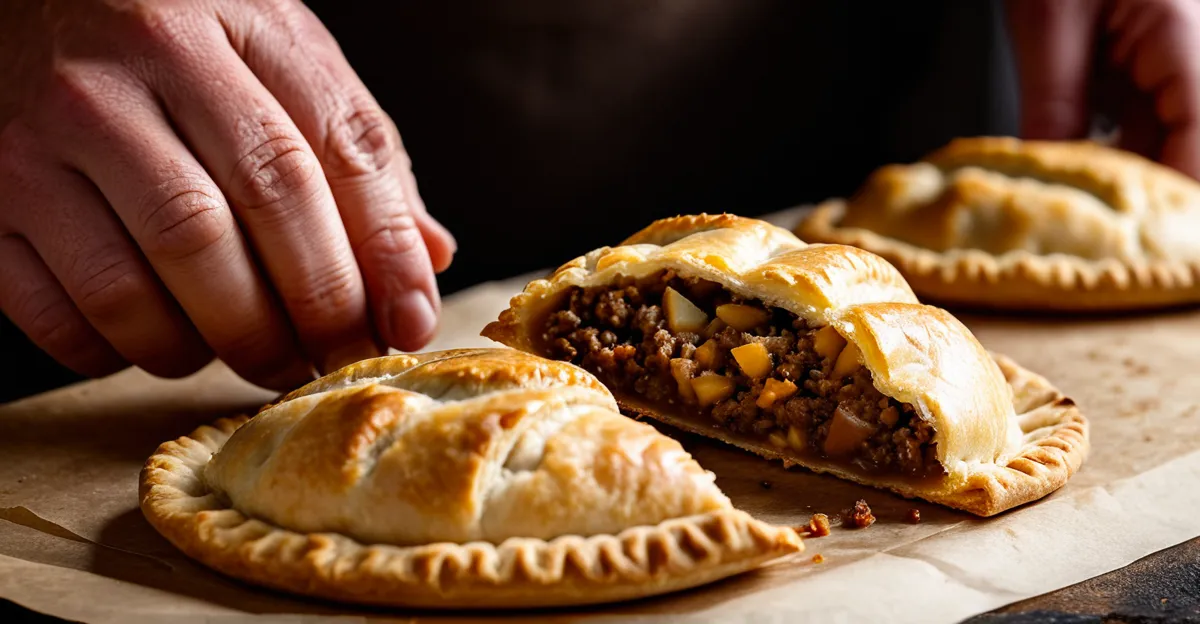Ingredients for a Classic Cornish Pasty
Creating a Cornish pasty requires a specific set of ingredients that honor its traditional roots. The pastry dough is a fundamental component, crafted with three basic ingredients—flour, lard, and water. For the pastry dough, it’s crucial to achieve a balance that is both rich and substantial, ensuring it can encase the hearty filling without mishap.
When it comes to the traditional pasty filling, simplicity meets heartiness. Key components include potatoes, swede (or rutabaga if you’re outside Cornwall), onion, and diced beef. The vegetables need to be chopped uniformly to cook evenly inside the pastry, while the beef should be seasoned well to enhance its flavor. This combination provides the authentic taste that the Cornish pasty is famed for.
Also to discover : What are the essential herbs and spices in British cuisine?
Herbs and spices play an understated but vital role in lifting the flavors of the filling. While the pasty’s essence is straightforward, a pinch of salt, pepper, and sometimes a dash of thyme or parsley can add depth and dimension, invigorating the taste without overshadowing the primary ingredients.
Preparing the Filling
Creating a standout Cornish pasty filling involves careful selection and preparation of ingredients. Start by selecting fresh, quality produce to form a solid base. Potatoes, swede, onion, and diced beef are the classic components of this dish. For the vegetables, ensure they are chopped uniformly; even pieces lead to even cooking. The beef should be diced small enough to cook thoroughly but large enough to maintain its moisture and tenderness during baking.
Topic to read : Australian wine and italian wine: a flavorful comparison
Meat preparation is key: season it well to bring out its natural flavors. A simple mix of salt and pepper suffices for purists, but adding herbs like thyme can provide an aromatic lift. Vegetable preparation requires precision—uniform pieces ensure they cook evenly and contribute to the hearty texture.
Balancing the flavors is paramount. The interplay between the savory beef, starchy potatoes, and subtly sweet swede creates a hearty filling that’s both satisfying and true to the pasty’s origins. Consider adding a touch of mustard powder or Worcestershire sauce for added depth of flavor, but take care to not overpower the traditional taste.
Preparing the Pastry
Creating the perfect pastry dough for a Cornish pasty involves methodical steps that ensure a delightful texture. Start with essential ingredients—flour, lard, and water, combined in specific proportions. For mixing, use a light hand to combine these ingredients, preventing overworking.
Mixing and Kneading
- Mix the flour and lard until the mixture resembles breadcrumbs, maintaining a balance that is neither too crumbly nor too sticky.
- Gradually add water, only enough to bind the ingredients into a dough. The ideal consistency should be smooth and slightly elastic.
Achieving the Right Texture
- Knead the dough gently for a few minutes to develop the gluten, which contributes to the pastry’s structure.
- Aim for a texture that is firm yet pliable; this ensures the pastry holds its shape during baking without becoming tough.
Resting and Chilling
- Cover the dough with a cloth and allow it to rest at room temperature for 15-30 minutes. This step relaxes the gluten, making it easier to roll out.
- For optimal results, chill the dough in the refrigerator for at least 30 minutes. Chilling enhances the dough’s flakiness, crucial for a thin, yet sturdy encasement.
By following these steps, you achieve a pastry dough that forms a perfect vessel for a satisfying Cornish pasty filling.
Assembling the Pasty
Assembling a Cornish pasty skillfully is key to preserving its traditional form and taste. To start, roll out the pastry dough to about 1/4 inch thickness, ensuring it’s even to avoid uneven cooking. This step requires precision—thin enough to cook perfectly, but thick enough to hold the generous filling.
Filling and Sealing the Pasty
Carefully spoon the filling onto one half of the pastry, ensuring a balanced mix of beef, potatoes, swede, and onion. Avoid overstuffing, allowing enough space for sealing. Fold the pastry over to create a semi-circle. Align the edges carefully, pressing down lightly to close the pasty.
Decorative Edges and Leak Prevention
Creating a decorative edge isn’t just about aesthetics; it strengthens the seal, preventing leaks. Crimp the edges starting from one side and working your way around. Use your index finger and thumb to twist the edge, ensuring it’s firm and secure. This classic technique not only enhances presentation but also keeps the savory contents secure during baking.
Cooking the Cornish Pasty
Baking a Cornish pasty to perfection involves understanding the delicate balance of time and temperature. Begin by preheating your oven to 200°C (392°F). This initial high heat is essential to ensure the pastry develops a crispy, golden exterior. After placing the pasties in the oven, bake for approximately 20 minutes.
Baking Times and Techniques
- After the initial bake, lower the temperature to 160°C (320°F) and continue baking for an additional 30-40 minutes. This allows the filling to cook through without burning the pastry.
Signs of Doneness
A well-cooked pasty should be evenly golden brown. Check that the pastry is firm and holds its shape, indicating that the interior is fully cooked. Listening for a slight sizzle from within can also be a cue that the juices are combining nicely.
Achieving a Golden Finish
Brushing the pasty with an egg wash before baking contributes to a shiny and appetizing crust. Combine one beaten egg with a splash of milk for best results. This step not only enhances color but also seals the edges during baking, preventing the filling from escaping.
By following these guidelines, you can produce a Cornish pasty with delightful texture and flavour balance, rooted in tradition yet appealing to modern tastes.
Serving and Storing the Pasty
Savouring a Cornish pasty at its best involves knowing the ideal serving and storage methods. Enjoying this traditional delicacy warm amplifies its flavours, showcasing the delicate balance of ingredients. Whether choosing to serve pasties as a standalone meal or alongside complementary sides, understanding presentation and pairings elevates the experience.
Best Practices for Serving
- Serve warm for a comforting, hearty meal straight from the oven.
- Pair with sides like peas, gravy, or a light salad. These side dishes complement the pasty’s rich and satisfying taste, adding a fresh or creamy contrast to the meal.
Storage Tips for Leftovers
Proper storage ensures that any leftovers maintain their delightful taste and texture. Once completely cooled, wrap the pasty in aluminum foil or place it in an airtight container. Refrigerate for up to three days. Reheat in the oven to retain the pastry’s flakiness rather than using a microwave, which can make it soggy.
Recommended Accompaniments
To fully embrace the Cornish culinary tradition, consider classic British sides. Mushy peas, a staple in British cuisine, can enhance the pasty’s hearty filling. Alternatively, a pickled beetroot salad offers a tangy contrast that refreshes the palate. These accompaniments both preserve the pasty’s authenticity and provide varied textures and flavours to the meal.
Historical Context and Variations
The Cornish pasty has a rich and storied history that is deeply intertwined with the traditions of Cornwall. Originating in the 13th century, it became a staple meal for Cornish miners. The sturdy pastry dough was ideal for carrying the hearty filling, providing a nutritious and portable lunch.
Origins and Cultural Significance
Initially, the Cornish pasty served as a fuel-packed food, easy to make and eat. The crimped edge is said to have allowed miners to hold the pasty with dirty hands and discard the crust after eating the filling. Over time, it gained culinary prestige and was awarded Protected Geographical Indication status in 2011, cementing its cultural importance.
Regional Variations
Different areas across the UK have developed unique pasty variations, often adapting the traditional filling to local tastes and available ingredients. Some regions incorporate different meats like chicken or lamb, while others add cheese or varied vegetables. Notably, Devon pasties, another famous variant, are folded differently, making them distinct yet related to the Cornish pasty.
Modern Twists
In today’s globalised world, the Cornish pasty has inspired numerous modern twists, appealing to a wider array of palates. Some bakers experiment with vegetarian or vegan fillings, offering a healthier alternative without sacrificing the classic taste. From spicy fillings with curry powder to sweet versions incorporating fruits, the pasty’s versatile nature continues to surprise and delight fans worldwide. These modern adaptations keep the beloved pastry relevant while celebrating its rich heritage.






